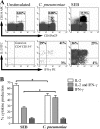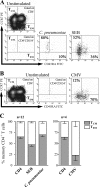Chlamydia pneumoniae-induced memory CD4+ T-cell activation in human peripheral blood correlates with distinct antibody response patterns
- PMID: 20219874
- PMCID: PMC2863398
- DOI: 10.1128/CVI.00209-09
Chlamydia pneumoniae-induced memory CD4+ T-cell activation in human peripheral blood correlates with distinct antibody response patterns
Abstract
Chlamydia pneumoniae is a frequent pathogen of the respiratory tract, and persistent infections with this obligate intracellular bacterium have been associated with different severe sequelae. Although T-cell activation during acute C. pneumoniae infections has been described, little is known about the frequency or the role of the C. pneumoniae-specific memory T cells that reside in the human body after the resolution of the infection. In the present study, the C. pneumoniae-induced T-cell responses in peripheral blood mononuclear cells of 56 healthy volunteers were analyzed and compared to the donor's serum antibody reactivity toward whole C. pneumoniae as well as recombinant C. pneumoniae antigens. Following short-term stimulation with C. pneumoniae, both gamma interferon (IFN-gamma)- and interleukin-2 (IL-2)-producing CD4(+) T-cell responses could be detected in 16 of 56 healthy individuals. C. pneumoniae-activated CD4(+) T cells expressed CD154, a marker for T-cell receptor-dependent activation, and displayed a phenotype of central memory T cells showing dominant IL-2 production but also IFN-gamma production. Interestingly, individuals with both IFN-gamma- and IL-2-producing responses showed significantly decreased immunoglobulin G reactivity toward C. pneumoniae RpoA and DnaK, antigens known to be strongly upregulated during chlamydial persistence, compared to IgG reactivity of seropositive individuals with no T-cell response or CD4(+) T-cell responses involving the production of a single cytokine (IFN-gamma or IL-2). Our results demonstrate that memory CD4(+) T cells responding to C. pneumoniae stimulation can be detected in the circulation of healthy donors. Furthermore, among seropositive individuals, the presence or the absence of dual IFN-gamma- and IL-2-producing T-cell responses was associated with distinct patterns of antibody responses toward persistence-associated C. pneumoniae antigens.
Figures





References
-
- Apfalter, P. 2006. Chlamydia pneumoniae, stroke, and serological associations: anything learned from the atherosclerosis-cardiovascular literature or do we have to start over again? Stroke 37:756-758. - PubMed
-
- Belland, R. J., S. P. Ouellette, J. Gieffers, and G. I. Byrne. 2004. Chlamydia pneumoniae and atherosclerosis. Cell. Microbiol. 6:117-127. - PubMed
-
- Benagiano, M., A. Azzurri, A. Ciervo, A. Amedei, C. Tamburini, M. Ferrari, J. L. Telford, C. T. Baldari, S. Romagnani, A. Cassone, M. M. D'Elios, and G. Del Prete. 2003. T helper type 1 lymphocytes drive inflammation in human atherosclerotic lesions. Proc. Natl. Acad. Sci. U. S. A. 100:6658-6663. - PMC - PubMed
-
- Benagiano, M., M. M. D'Elios, A. Amedei, A. Azzurri, R. van der Zee, A. Ciervo, G. Rombola, S. Romagnani, A. Cassone, and G. Del Prete. 2005. Human 60-kDa heat shock protein is a target autoantigen of T cells derived from atherosclerotic plaques. J. Immunol. 174:6509-6517. - PubMed
Publication types
MeSH terms
Substances
LinkOut - more resources
Full Text Sources
Medical
Research Materials

